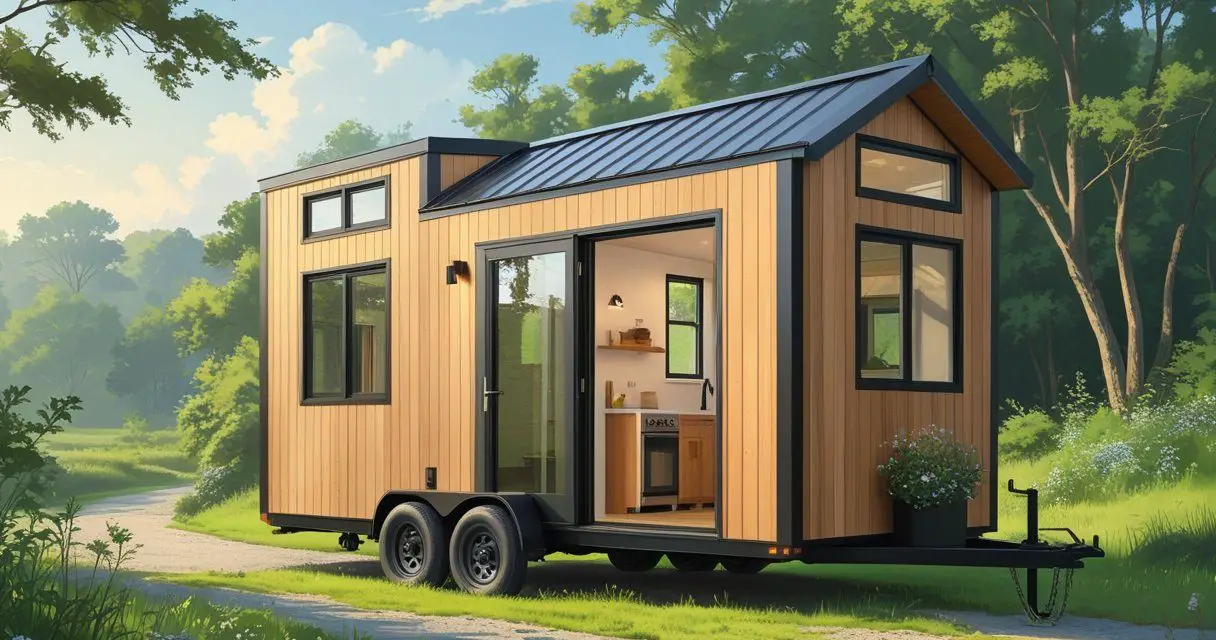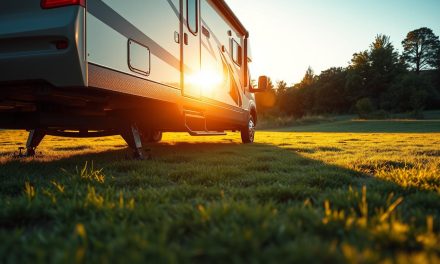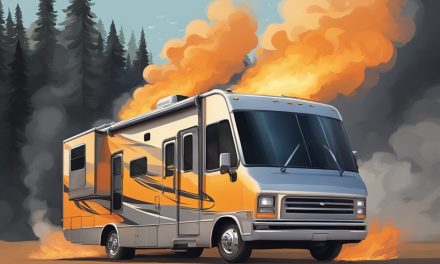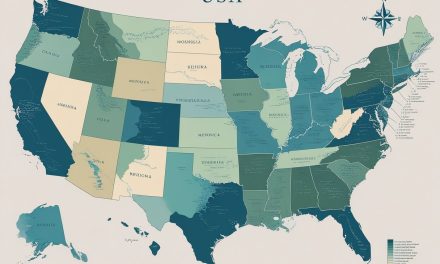Would you like to save this article?
Finding a legal place to park your tiny home can feel like searching for a needle in a haystack. If you’ve been eyeing RV parks as a potential solution, you’re not alone. Many tiny home enthusiasts wonder if these established communities might offer the perfect blend of amenities, community, and legal acceptance. This comprehensive guide will answer the burning question: can tiny homes be parked in RV parks?
The short answer to whether tiny homes can be parked in RV parks is: yes, but with conditions.
Most RV parks will accept tiny homes that meet certain criteria, particularly those built to recognized RV standards. However, acceptance varies widely depending on local regulations, park policies, and how your tiny home is classified.
We’ll explore the requirements, challenges, and opportunities for parking your tiny home in an RV park, along with practical tips to increase your chances of approval. Whether you’re planning your first tiny home or looking to relocate an existing one, this information will help you navigate the sometimes confusing world of tiny home parking options.
Understanding Tiny Homes and RV Parks
Tiny homes can often integrate seamlessly into RV park communities when they meet certain requirements
Before diving into whether tiny homes can park in RV parks, it’s important to understand what each of these terms actually means. Tiny homes typically range from 100-400 square feet and can be built on foundations or wheels. When built on wheels, they’re often called Tiny Houses On Wheels (THOWs).
RV parks, on the other hand, are designated areas where people can park recreational vehicles like motorhomes, travel trailers, and fifth wheels. These parks usually offer amenities such as electricity, water, sewer connections, and sometimes additional facilities like laundry rooms, bathrooms, and community spaces.
Certification Requirements for Parking Tiny Homes in RV Parks
The single most important factor determining whether your tiny home can be parked in an RV park is certification. Most RV parks require that any vehicle or structure parked on their premises meets recognized safety standards.
RVIA Certification: The Golden Ticket
An RVIA certification badge is often the key to gaining acceptance at RV parks
The Recreational Vehicle Industry Association (RVIA) certification is considered the gold standard for tiny homes seeking to park in RV parks. When a tiny home is RVIA certified, it means it has been built to meet the same safety standards as traditional RVs, including:
- Electrical systems that meet national safety codes
- Proper plumbing installations
- Safe propane systems
- Appropriate ventilation
- Fire safety measures
Many RV parks will immediately accept an RVIA-certified tiny home because this certification essentially classifies your tiny home as an RV in the eyes of the park management.
Alternative Certifications
If your tiny home doesn’t have RVIA certification, there are other options that might help with RV park acceptance:
- NOAH (National Organization of Alternative Housing) certification
- State-specific certifications (varies by location)
- Professional builder certifications
- Local inspection certificates
Not Sure If Your Tiny Home Meets Standards?
Many tiny home builders can help you understand certification requirements and even assist with obtaining proper documentation for your home.
Size and Design Requirements
Understanding size limitations is crucial for RV park acceptance
Beyond certification, the physical dimensions of your tiny home play a crucial role in determining whether an RV park will accept it. Most RV parks have specific size restrictions based on their lot sizes and infrastructure.
Typical Size Limitations
| Dimension | Typical Maximum | Considerations |
| Height | 13.5 feet | Must clear overhead obstacles like trees and power lines |
| Width | 8.5 feet | Standard road-legal width without special permits |
| Length | 40 feet | Varies widely depending on the RV park’s lot sizes |
| Weight | Varies | Must be towable and not damage park infrastructure |
Design Considerations
Beyond just size, the design of your tiny home can impact RV park acceptance:
Features That Help With Acceptance
- Standard RV hookups (30/50 amp electrical, water, sewer)
- Wheels that remain attached
- Towable design with proper hitch
- Professional exterior finish
Features That May Cause Issues
- Unusual shapes or dimensions
- Non-standard utility connections
- Permanent-looking features (large porches, etc.)
- DIY appearance without professional finishing
How to Find RV Parks That Accept Tiny Homes
Research is key to finding the right RV park for your tiny home
Finding an RV park that welcomes tiny homes requires research and the right approach. Here are effective strategies to identify potential parking spots:
Research Methods
Online Resources
- Tiny house community forums
- Facebook groups for tiny house enthusiasts
- Specialized directories like Tiny House Hosting
- RV park review websites
Direct Contact
- Call RV parks directly
- Email with photos of your tiny home
- Visit in person when possible
- Attend tiny house meetups for recommendations
Apps & Websites
- Campendium
- RV Parky
- Good Sam Club
- Hipcamp (for more unique options)
Questions to Ask RV Parks
When contacting RV parks, how you frame your questions can significantly impact your success rate. Here’s a strategic approach:
“Hello, do you offer long-term parking for RVs and park model homes? My unit is RVIA certified and I’m looking for a community to join.”
– Recommended approach when calling RV parks
Additional questions to ask:
- What are your requirements for long-term stays?
- Do you have any size or age restrictions for RVs?
- What hookups are available at your sites?
- Are there any specific certifications you require?
- What are your monthly rates for long-term stays?
- Do you have any other tiny homes currently at your park?
Pro Tip: Avoid using the term “tiny house” when first contacting RV parks. Instead, refer to your home as an “RVIA-certified park model” or “custom RV” to avoid immediate rejection based on terminology.
Legal Considerations and Zoning Regulations
Understanding local zoning regulations is essential for legal tiny home parking
Even if an RV park is willing to accept your tiny home, you still need to consider the broader legal landscape. Zoning regulations and local laws can impact your ability to live in your tiny home, even within an RV park.
Common Legal Hurdles
- Occupancy Restrictions: Many jurisdictions limit how long someone can live in an RV, which may apply to tiny homes in RV parks.
- Zoning Classifications: Some areas have specific zoning that prohibits full-time living in recreational vehicles.
- Building Codes: Even in an RV park, local building codes may apply to structures intended for permanent habitation.
- Tax Implications: How your tiny home is classified can affect property taxes and registration requirements.
Navigating the Legal Landscape
To navigate these challenges, consider these approaches:
Research Local Regulations
- Contact the local planning department
- Review municipal codes online
- Speak with local tiny home owners
- Consult with a real estate attorney familiar with alternative housing
Potential Solutions
- Apply for variances or special permits
- Look for RV parks in counties with less restrictive zoning
- Consider seasonal movement to comply with temporary stay requirements
- Join advocacy groups working to change local regulations
Legal Disclaimer: Regulations vary widely by location and change frequently. Always verify current local laws and consult with legal professionals before making decisions about where to park your tiny home.
Alternative Parking Options Beyond RV Parks
Private land offers more freedom but comes with its own set of challenges
If RV parks aren’t the right fit for your tiny home, several alternative options exist. Each comes with its own set of advantages and challenges:
Private Land Options
Your Own Land
Purchasing land specifically for your tiny home provides the most freedom but requires navigating local zoning laws.
- Complete privacy and control
- No monthly lot fees
- Freedom to customize your surroundings
- Potential for off-grid living
Leased Land
Renting space on someone else’s property can be an affordable middle ground.
- Lower initial investment than buying land
- Often more flexible than RV parks
- Potential for rural settings
- May include utilities or amenities
Backyard ADUs
Some jurisdictions allow tiny homes as Accessory Dwelling Units (ADUs) in the backyard of existing homes.
- Legal in many urban and suburban areas
- Access to established neighborhoods
- Potential rental income for the property owner
- Often requires foundation rather than wheels
Specialized Communities
Dedicated tiny home communities offer a supportive environment specifically designed for tiny living
Beyond individual parking options, specialized communities are emerging specifically for tiny homes:
- Tiny Home Villages: Purpose-built communities exclusively for tiny homes, often with shared amenities and community spaces.
- Cohousing Communities: Intentional communities where tiny homes may be integrated with other housing types around shared resources.
- Eco-Villages: Sustainability-focused communities that often welcome alternative housing including tiny homes.
- Mobile Home Parks: Some mobile home parks are evolving to welcome tiny homes, especially those built to park model standards.
Practical Tips for Tiny Home Owners Seeking RV Park Placement
Proper setup and connections are essential for successful RV park living
If you’ve decided that an RV park is the right option for your tiny home, these practical tips will help increase your chances of acceptance and ensure a positive experience:
Before Approaching RV Parks
- Prepare Documentation: Have photos, dimensions, certification information, and insurance documents ready to share.
- Understand Hookups: Ensure your tiny home can connect to standard RV hookups (30/50 amp electrical, water, sewer).
- Consider Appearance: A well-maintained, professional-looking tiny home is more likely to be accepted.
- Research the Park: Look for parks that already have park models or other tiny homes.
During Your Stay
Setting Up Successfully
- Use proper leveling techniques
- Connect utilities according to park guidelines
- Secure your tiny home appropriately
- Create an attractive, tidy outdoor space
Being a Good Neighbor
- Follow all park rules and quiet hours
- Keep your site neat and organized
- Participate in community activities
- Be respectful of shared facilities
Long-Term Considerations
Creating a comfortable long-term setup while respecting park rules is possible with creativity
- Weather Preparations: Understand how to prepare your tiny home for the local climate and seasonal changes.
- Community Building: Develop relationships with park management and neighbors to create a supportive environment.
- Mobility Plan: Even in long-term situations, have a plan for moving your tiny home if necessary.
- Legal Compliance: Stay informed about any changes to local regulations that might affect your stay.
“The key to successfully parking a tiny home in an RV park isn’t just meeting technical requirements—it’s about building relationships and becoming a valued community member.”
Conclusion: Is an RV Park Right for Your Tiny Home?
For many tiny home owners, RV parks offer the perfect balance of community, amenities, and legal acceptance
Parking a tiny home in an RV park is indeed possible, though it comes with specific requirements and considerations. The key factors that determine success include proper certification (particularly RVIA), appropriate size and design, and finding parks with compatible policies.
For many tiny home owners, RV parks offer an excellent solution that provides:
- Legal placement with proper utilities
- Community and social opportunities
- Shared amenities that enhance tiny living
- Flexibility to relocate if desired
However, RV parks aren’t the perfect solution for everyone. Those seeking more privacy, permanent placement, or freedom from community rules might prefer alternative options like private land or dedicated tiny home communities.
Ultimately, the best approach is to thoroughly research your options, understand the legal landscape in your desired location, and prepare your tiny home to meet the necessary requirements. With proper planning and the right approach, you can find the perfect spot to park your tiny home and enjoy the freedom and simplicity of tiny living.
Frequently Asked Questions About Parking Tiny Homes in RV Parks
Do all RV parks accept tiny homes?
No, not all RV parks accept tiny homes. Acceptance varies widely depending on the park’s policies, local regulations, and how your tiny home is classified. Parks that accept park models or custom RVs are more likely to welcome tiny homes, especially those with RVIA certification.
Can I live full-time in my tiny home at an RV park?
Many RV parks do allow full-time or extended stays, though some have limitations on how long you can stay. Even in parks that technically don’t allow permanent residency, many have seasonal residents who stay for extended periods. It’s important to be upfront about your intentions when discussing options with park management.
What if my tiny home doesn’t have RVIA certification?
While RVIA certification makes acceptance much easier, some RV parks will consider non-certified tiny homes on a case-by-case basis. Having alternative certifications, professional build documentation, or inspection reports can help. Some parks may require an on-site inspection before approval.
How much does it typically cost to park a tiny home in an RV park?
Costs vary widely depending on location, amenities, and season. Monthly rates typically range from $400-$1,200, with additional charges for electricity and other utilities. Some parks offer discounted rates for longer stays or off-season periods.
What’s the difference between parking in an RV park versus a tiny home community?
RV parks are designed primarily for recreational vehicles with temporary stays in mind, though many accommodate longer-term residents. Tiny home communities are specifically designed for tiny houses, often with more permanent infrastructure, community-focused amenities, and regulations tailored to tiny home living rather than RV travel.





